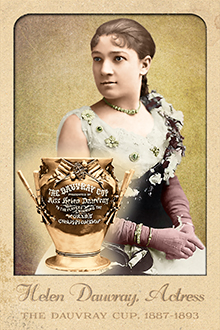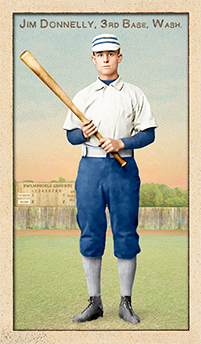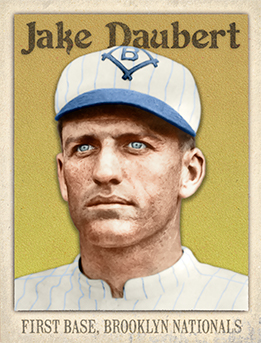
- Series: 1880s: Spotted Ties
- City: New York
- Team: Metropolitans
- League: American Association
James Augustus Donahue (1862-1935) debuted with the New York Metropolitans on April 19, 1886 where he would play outfield and catch through the following season. He played his entire major league career with American Association clubs, moving to the Kansas City Cowboys for two years and finishing with the Columbus Solons in 1891 after a one year absence from the upper echelons of the game. His sophomore season proved his best. Jim was back-up to Bill Holbert and batted .282. New York sent Donahue to the Brooklyn Bridegrooms following the '87 season but Brooklyn dealt him to KC that winter. Donahue's rookie year had seen him labor for a struggling Metropolitan squad who finished in seventh place, 38 games behind the St. Louis Browns who bested them 16 times in 20 contests. As noted above, the next year proved much more satisfying for Jim, and, when he moved west, his playing time increased. He was the starting receiver for the Cowboys, appearing in 88 games. That '88 season found Donahue embroiled in a controversy. Dragooned into the role of substitute umpire on two occasions, Donahue was accused by Brooklyn's Adonis Terry of heeding an order from KC manager Sam Barkley to call a Bridegroom runner out in the ninth inning of a 5-4 match. Brooklyn left the field in protest and suffered a forfeit.
- Jim's career line included a .234 BA, with 2 HRs and 33 steals
Auction History
Cartophilia
Old Judge Pose: 128-1

- Series: Pioneer Portraits II: 1875-1899
- League: National League
Ida Louisa Gibson (1856-1923), aka Helen Dauvray, was a child prodigy on the stage whose subsequent real estate investments made her wealthy. By 1887 her acting career was waning, but she had grown accustomed to and still longed for the acclaim accorded theatrical stars of her era. A love affair with celebrated baseball hero John Montgomery Ward was budding when Helen announced she would commission a "$500 . . . true lover's cup" to be presented annually to the players who triumphed in the “World's Championship” between the American Association and National League. In an era of shameless self-promotion, Helen's award gained traction in baseball and cast her back into the spotlight. It endured precisely as long as the romance between Monty Ward and the woman still known by many as Little Nell, the California Diamond after a long-running role of Helen's.
The Gorham Silver Co. finished the 12" tall cup on June 1, charging Helen $250. It was engraved “THE DAUVRAY CUP, Presented By Miss Helen Dauvray, to the players winning the WORLD'S CHAMPIONSHIP.” It didn't take long for some to realize that the cup would undoubtedly reside in the team owner's office, so Dauvray also commissioned medals to be given to individual players, a few of which survive in the Hall of Fame and private collections today.
Alas, the Dauvray Cup is now lost to history, having served its purpose from 1887-1893. The American Association expired following the 1890 tournament, so Miss Dauvray redirected it to become the trophy for the National League's champions. Helen had proposed that the cup become the permanent property of any club to win it three times consecutively, and the Boston Beaneaters took final possession following their third straight win in the fall of 1893. The cup was known to be in Kentucky that winter but, sadly, has disappeared since. Perhaps fittingly, the end of the cup's reign coincided with the Ward-Dauvray union's demise. Married in '87, the celebrity couple divorced in 1893.
The first recipients of the cup were not, as Dauvray may have expected, Ward's Giants. Rather, the Detroit Wolverines captured it first in a marathon 15-game series that was as much a barnstorming tour as a post-season tourney. The cup toured with the teams that inaugural year and offered Miss Dauvray the attention she sought, being displayed on the field during each game. In 1894, Helen's legacy lived on in the Temple Cup, instituted by Pirates owner William Chase Temple, to honor the winners of the NL's seven-game post-season series. It was awarded four times, last in 1897. Unlike its predecessor, the Temple Cup resides today in Cooperstown.
- Ars Longa is indebted to baseball historian John Thorn for his excellent research on the Dauvray Cup and the delightfully insouciant Miss Dauvray herself

- Series: Beginnings: 1880's
- City: St. Louis
- Team: Browns (AA)
- League: American Association
James H. Devlin (1866-1900) was another of those Troy, NY (Lansingburgh) ballplayers to make an impact on the major leagues in the 19th century. The game was growing into a national pastime and Troy was at its center in the post-Civil War years when Devlin was born. He began with Syracuse of the International League in the spring of 1886, going 2-4 with a 1.05 ERA, which earned him a call-up to the NL's Giants that summer. He would continue to shuttle between major and minor league clubs for the next decade. His time in the big leagues included two more teams, the Philadelphia Quakers and the St. Louis Browns, then of the American Association. After the 1889 season in St. Louis, Devlin was out of baseball for a year before leading the Eastern League's Albany Senators with 26 wins in 40 decisions in '91. His MLB record was a mere 11-10, but he compiled a very respectable 3.38 ERA. Like so many before and since, Devlin fared much better in the minors. Jim would play in the Eastern and Pennsylvania Leagues through the mid-'90s and closed his professional career in the Canadian League, going 2-0 for London despite surrendering 14 runs. Every pitcher would pray for such support.
- All together Devlin won 106 games in the minors, including 21 with his hometown Troy Trojans
- Among many major leaguers to perish at too young an age, Devlin succumbed to typhoid fever at 34 back in Troy
- Series: Diamond Heads '15
- City: Brooklyn
- Team: Robins
- League: National League
Jacob Ellsworth Daubert (1884-1924) is considered by some the best first-baseman NOT in the Hall. His fielding was never below .989, he led the NL in batting 1913 & ’14, and was MVP in ’13. Seven times from 1911-19 he was named to Baseball Magazine’s All-America team. Popular with players and fans, his union activity alienated management.
- Charles Ebbetts sent him from Brooklyn to the Reds in 1919 following a salary dispute
- Became ill and died during his final road trip with the Reds in 1924

- Series: Beginnings: 1880's
- City: Washington, D.C.
- Team: Nationals
- League: National League
James B. Donnelly (1865-1915) had eleven seasons in the majors, playing third base for nine teams. While he toiled in relative obscurity for most of his career, Donnelly had the thrill, in its waning days, of being part of a remarkable championship season with the Orioles in 1896. In that storied year, the club walked away with its third straight NL pennant, besting second-place Cleveland to win the Temple Cup in the post-season. Donnelly had, by far, his greatest offensive production in ‘96, hitting .328 - over a hundred points above his lifetime average. That effort would have been a headliner for any other team, but in Baltimore Donnelly was only the sixth-best on the squad. Jim was overshadowed by pretty good men: Wilbert Robinson .347, Jack Doyle .339, Hughie Jennings .401, Willie Keeler .386, and Joe Kelley .364. Talk about Murderers Row! The Ned Hanlon/John McGraw powerhouse was soon to disband as the NL went from twelve to eight teams to accommodate the new American League a few years later.




